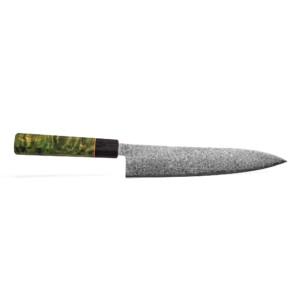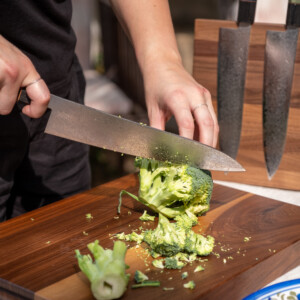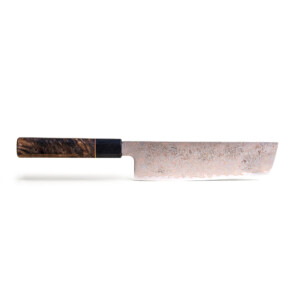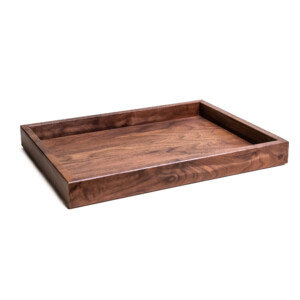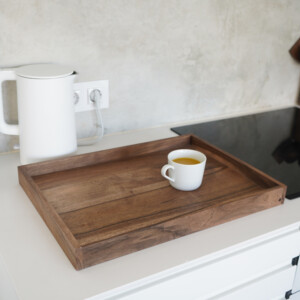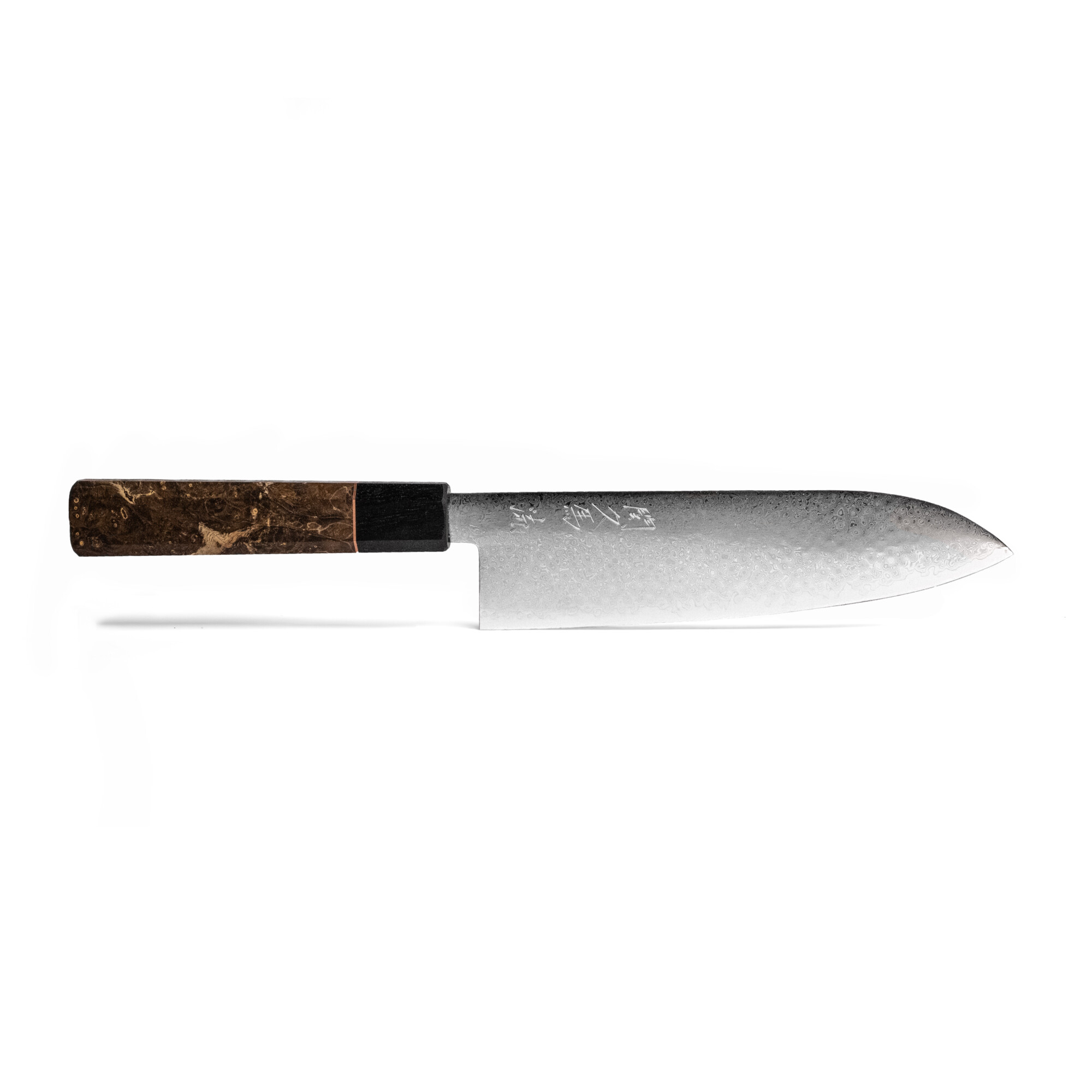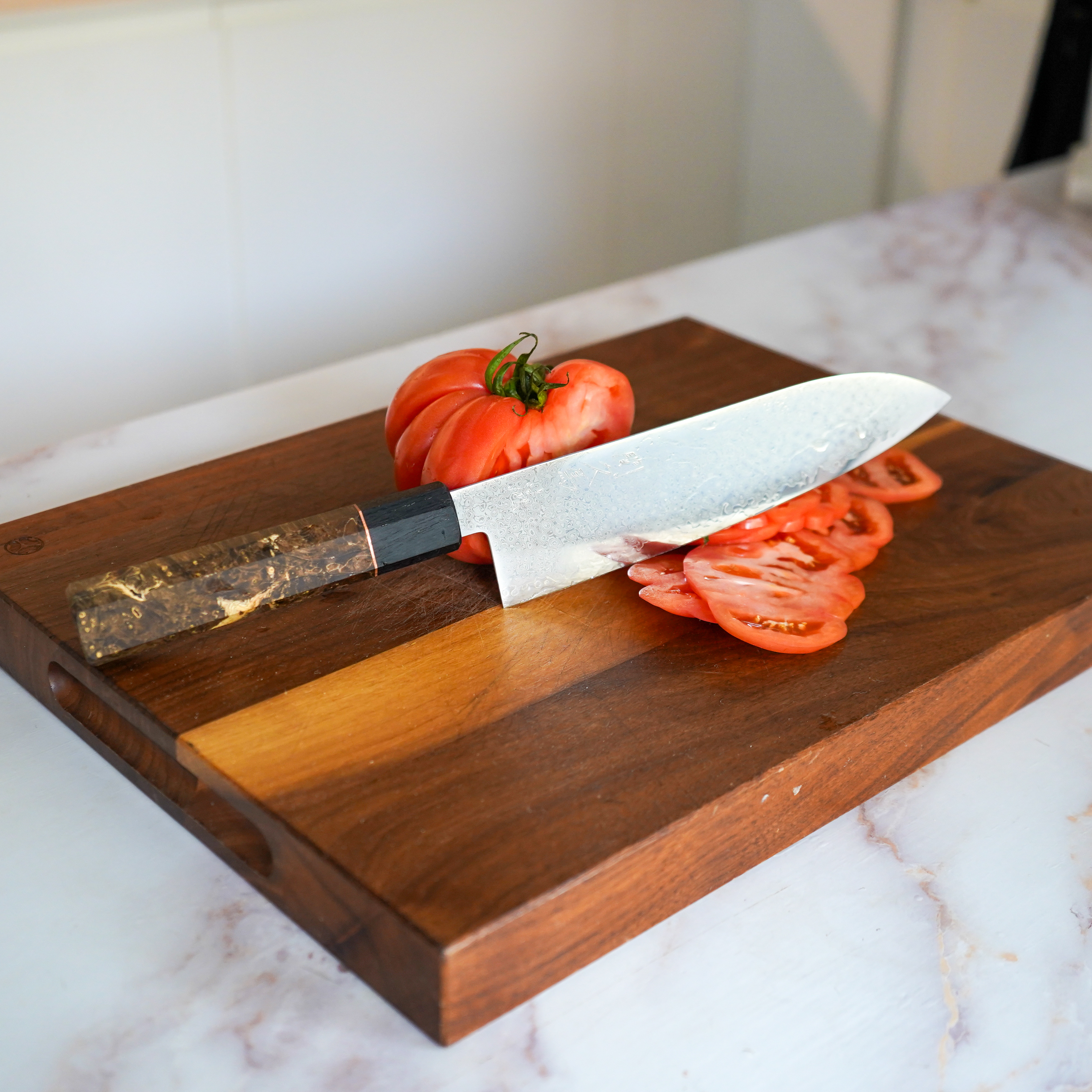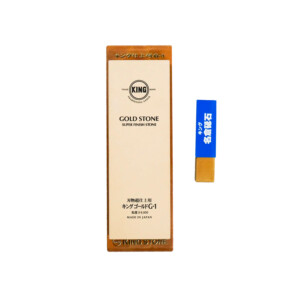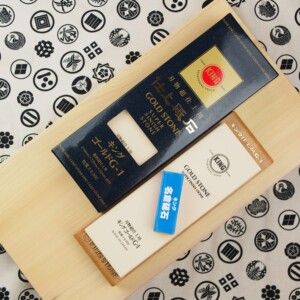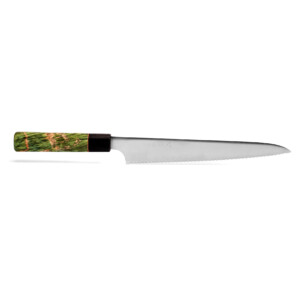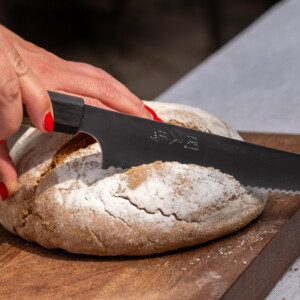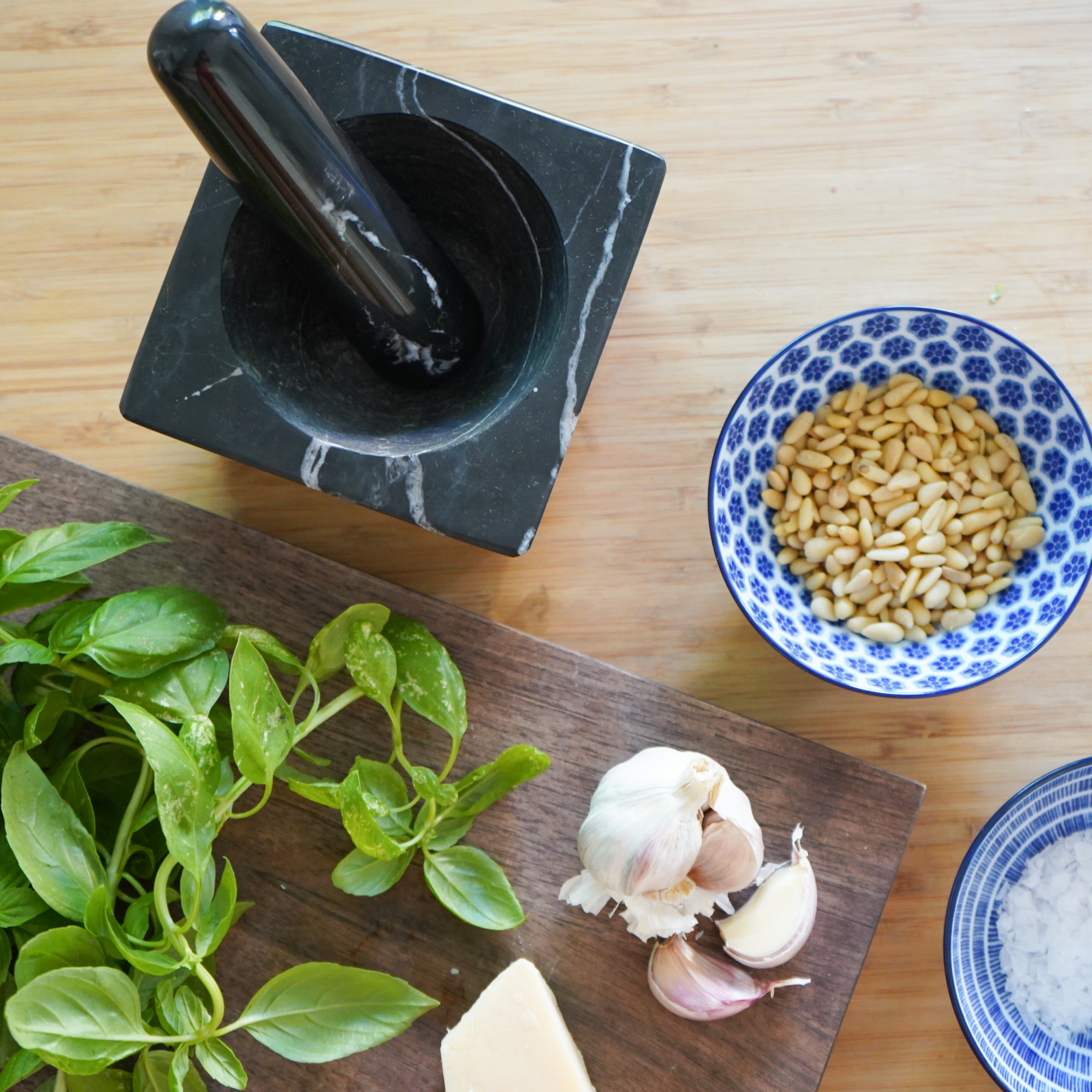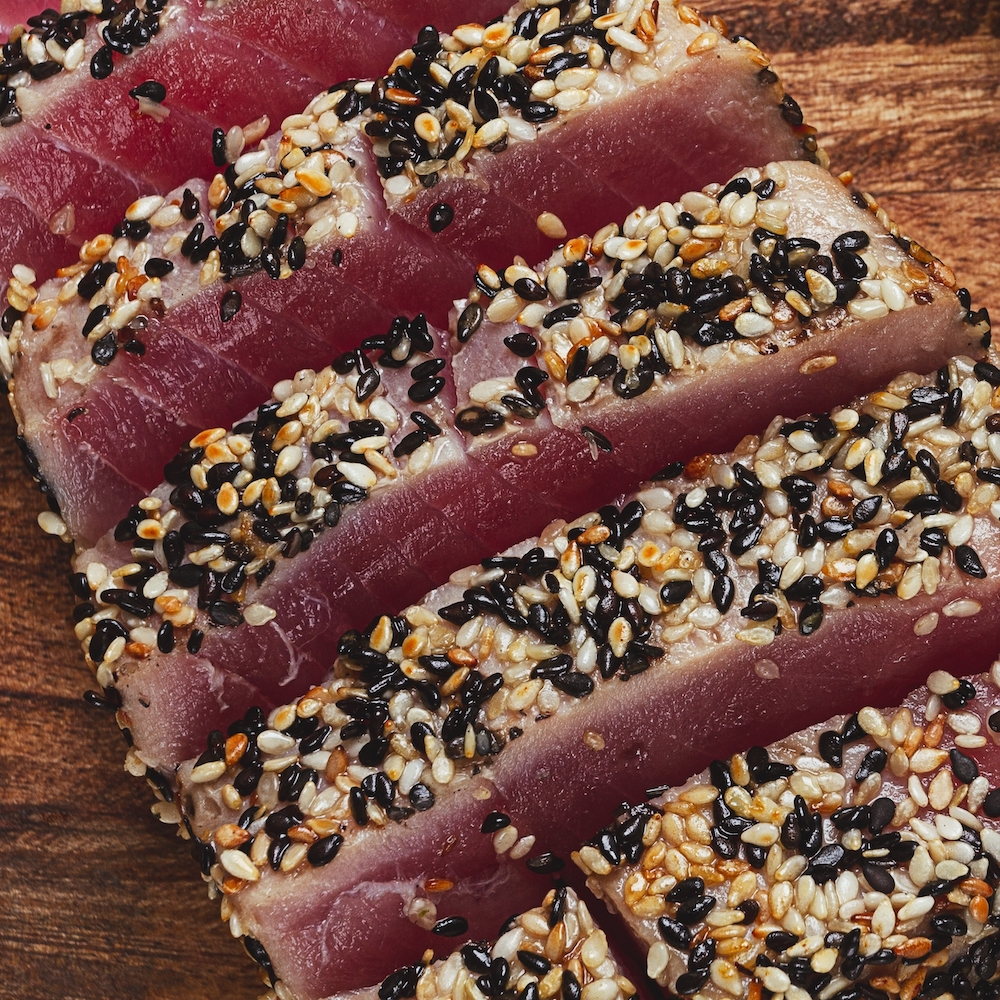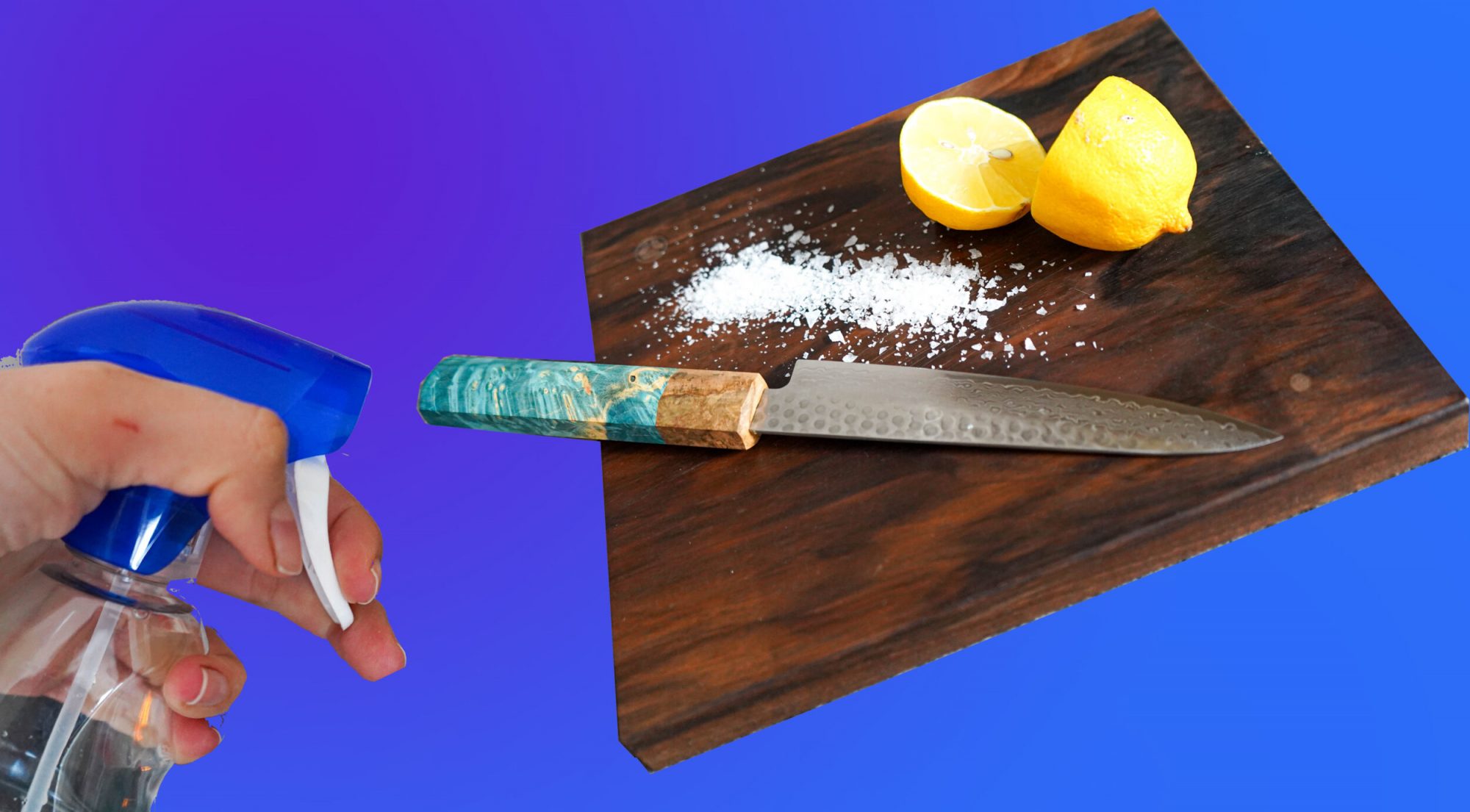As a home cook, you understand the importance of having the right tools in your kitchen. And when it comes to knives, Japanese kitchen knives have garnered a well-deserved reputation for their exceptional craftsmanship, cutting performance, and rich cultural heritage. But with a wide variety of Japanese knife types and styles available, it can be overwhelming to navigate the world of these exquisite culinary tools, especially if you’re not familiar with Japanese names and terminology. Fear not! In this comprehensive guide, we will explore the diverse range of Japanese kitchen knife types and styles, shedding light on their unique characteristics, uses, and helping you make informed choices for your culinary pursuits. So, let’s embark on a journey through the captivating world of Japanese knives. This guide covers:
- Understanding Japanese Kitchen Knives
- The Art of Japanese Knife-Making
- Key Features of Japanese Knives
- Importance of Sharpness and Cutting Performance
- Common Japanese Knife Types
- Gyuto
- Santoku
- Nakiri
- Deba
- Yanagiba
- Petty
- Sujihiki
- Usuba
- Honesuki
- Specialized Japanese Knife Styles
- Damascus Knives
- Honyaki Knives
- Kasumi Knives
- Kurouchi Knives
- Suminagashi Knives
- Tamahagane Knives
- Choosing the Right Japanese Knife for Your Needs
- Considerations for Home Cooks
- Knife Maintenance and Care
- Recommended Japanese Knife Brands
- Budget-Friendly Options
- Using Japanese Kitchen Knives: Techniques and Tips
- Proper Grip and Handling
- Knife Skills and Cutting Techniques
- Honing and Sharpening
- Knife Maintenance
- Proper handling and cutting techniques
- Frequently Asked Questions
- Are Japanese Kitchen Knives Suitable for Home Cooks?
- How Do Japanese Knives Differ from Western Knives?
- Can I Use Japanese Knives for Different Types of Cuisine?
- Conclusion: Embracing the Art of Japanese Knife-Making
1. Understanding Japanese Kitchen Knives
1.1 The Art of Japanese Knife-Making
Japanese knife-making is not just a craft; it is an art form deeply rooted in centuries of tradition and cultural significance. The history of Japanese knives dates back to the days of samurai sword-making, where the same meticulous techniques were applied to create these culinary tools. Master blacksmiths, known as “Tosho,” have honed their skills over generations, passing down their knowledge and techniques. These artisans blend traditional methods with modern innovations to create knives of exceptional quality and beauty.
1.2 Key Features of Japanese Knives
Japanese knives are known for several key features that set them apart from their Western counterparts. One significant characteristic is the blade construction. Japanese knives are available in both single bevel and double bevel variations. Single bevel knives, known as “Yanagi” or “Usuba,” have a sharpened edge on one side only, making them ideal for precise cuts. Double bevel knives, such as the popular “Gyuto” and “Santoku,” have sharpened edges on both sides, offering versatility and ease of use.
Another important feature is blade geometry. Japanese knives are renowned for their thin and lightweight blades, allowing for precise and effortless cutting. The thinness of the blade enhances cutting performance, allowing for clean, precise cuts with minimal effort.
Materials play a crucial role in Japanese knife-making. High carbon steel and stainless steel are commonly used, each offering unique properties. High carbon steel blades have excellent sharpness and edge retention but require more maintenance to prevent rust. Stainless steel blades, on the other hand, are easier to maintain and resistant to corrosion.
Handle types also differ in Japanese knives. “Wa-handle” refers to traditional Japanese handles made of materials like wood or horn. They offer a comfortable grip and balance. “Yo-handle” refers to Western-style handles, which may incorporate materials like plastic or synthetic materials. The choice of handle type is a matter of personal preference and comfort.
Balance and weight distribution are crucial factors in Japanese knives. They are designed to provide a perfect balance between the blade and the handle, allowing for precise control and reducing fatigue during extended periods of use.
1.3 Importance of Sharpness and Cutting Performance
Sharpness is at the core of Japanese knife-making philosophy. Japanese knives are renowned for their exceptional sharpness, enabling effortless cutting through even the most delicate ingredients. Achieving and maintaining this level of sharpness requires precise craftsmanship and attention to detail. The acute edge angle of Japanese knives allows for clean cuts without crushing or tearing the food, preserving its texture and flavor.
The cutting performance of Japanese knives is unparalleled. The combination of the thin blade, sharp edge, and excellent balance results in precise, efficient cutting motions. Whether you’re slicing sashimi, dicing vegetables, or deboning meat, Japanese knives offer exceptional cutting performance that enhances your culinary skills.
2. Common Japanese Knife Types
2.1 Gyuto
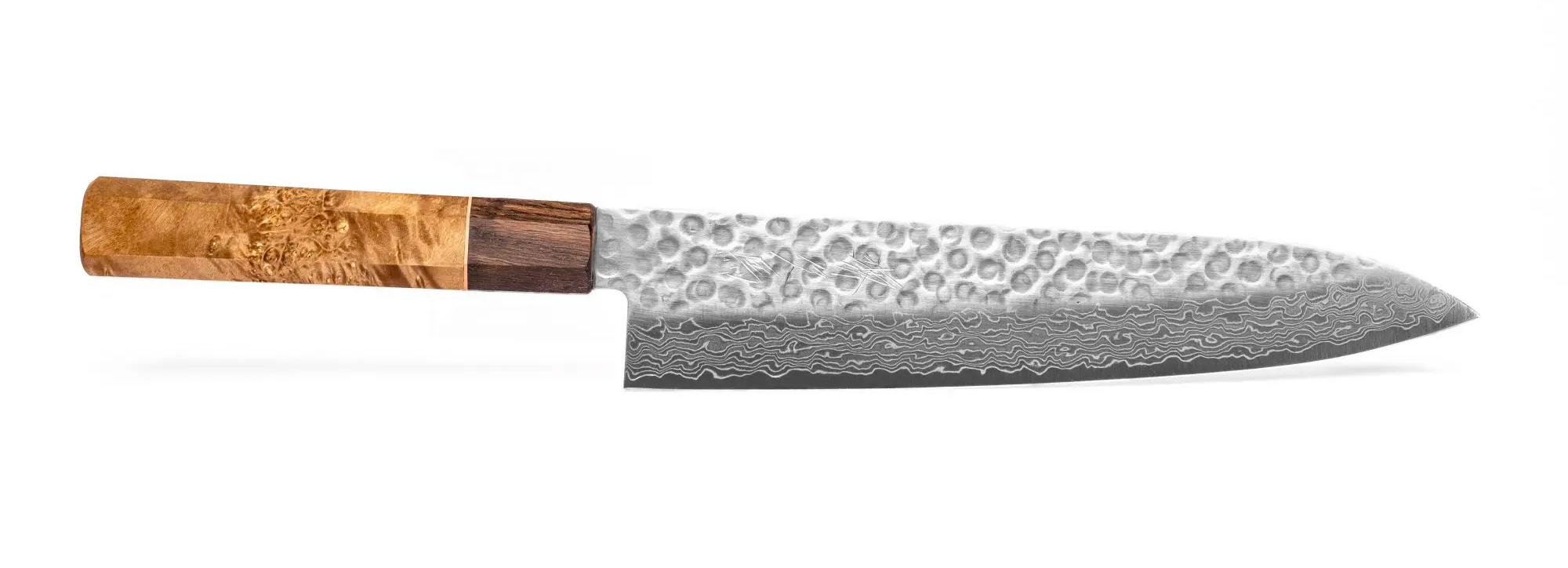
The Gyuto, often referred to as the Japanese chef’s knife, is a versatile workhorse in the kitchen. Its name translates to “cow sword,” reflecting its origins as a Western-style knife adapted to the Japanese culinary tradition. The Gyuto features a long, slender blade with a slight curve, allowing for fluid rocking motions or precise push-pull cuts. It excels at a wide range of tasks, including slicing, dicing, and chopping, making it an ideal choice for home cooks seeking a multi-purpose knife.
2.2 Santoku
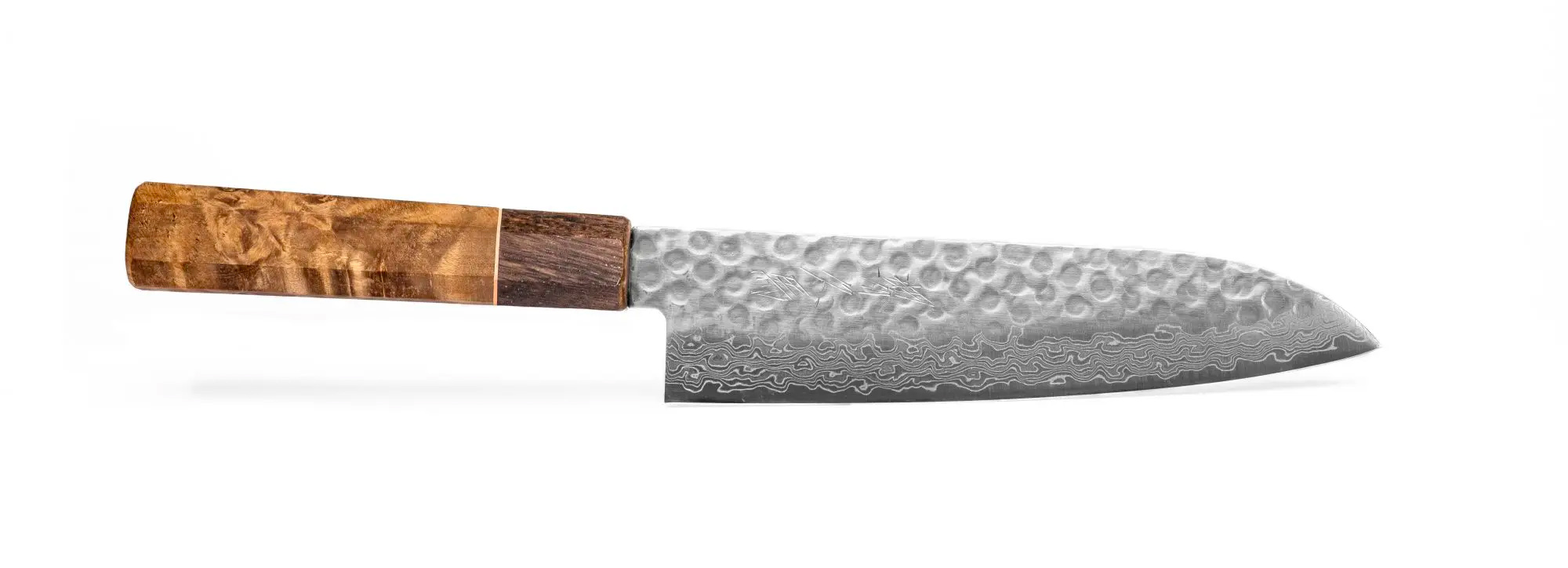
The Santoku, meaning “three virtues,” is a popular Japanese knife that has gained global recognition. It features a shorter and wider blade compared to the Gyuto, with a straighter edge and a flat profile. The Santoku is designed for versatility, excelling at tasks like slicing, dicing, and chopping vegetables, as well as cutting meat and fish. Its wider blade allows for easy food transfer from the cutting board to the pan or plate. The Santoku’s compact size and ergonomic design make it a favorite among home cooks for everyday use.
2.3 Nakiri
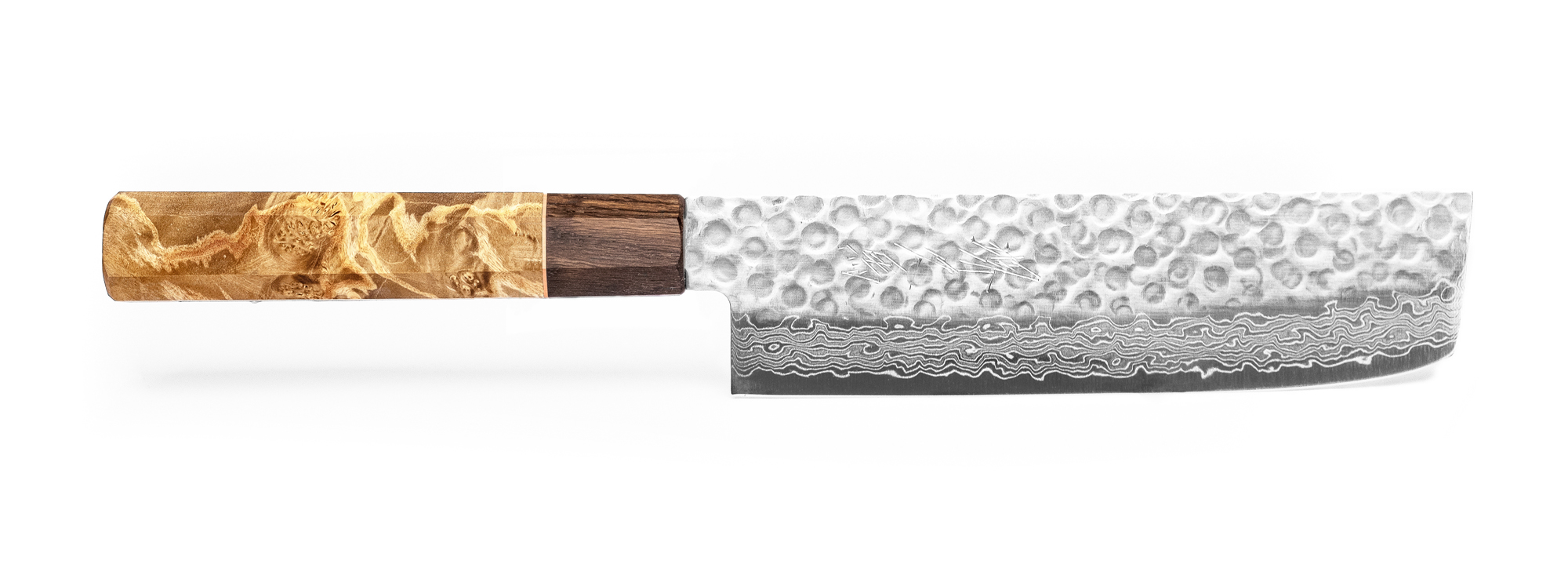
The Nakiri, also known as the vegetable knife, is a specialized tool designed for precise vegetable preparation. It features a straight, rectangular blade with a thin profile, allowing for efficient push cuts and downward slicing. The flat edge of the Nakiri makes it ideal for achieving clean, precise cuts on vegetables, herbs, and fruits. With its emphasis on vegetable-centric cuisine and precise cutting, the Nakiri is a must-have for home cooks who enjoy the art of vegetable preparation.
2.4 Deba
The Deba is a traditional Japanese knife specifically designed for fish and meat preparation. It features a thick, heavy blade with a sturdy spine and a single bevel edge. The Deba excels at tasks like filleting fish, butchering poultry, and breaking down large cuts of meat. The robust construction and sharpness of the Deba allow for clean, precise cuts through tough ingredients. Whether you’re a seafood enthusiast or an avid meat lover, the Deba is a powerful tool in the kitchen.
2.5 Yanagiba
The Yanagiba, also known as the sushi and sashimi knife, is a long, slender knife with a single bevel edge. It is specifically designed for slicing raw fish and creating thin, precise cuts. The Yanagiba’s long blade allows for smooth, continuous cutting motions, resulting in clean slices of sashimi or sushi. The single bevel edge ensures minimal tearing and preserves the delicate texture of the fish. If you’re passionate about Japanese cuisine or enjoy preparing raw fish dishes, the Yanagiba is an essential tool for achieving professional-grade results.
2.6 Petty
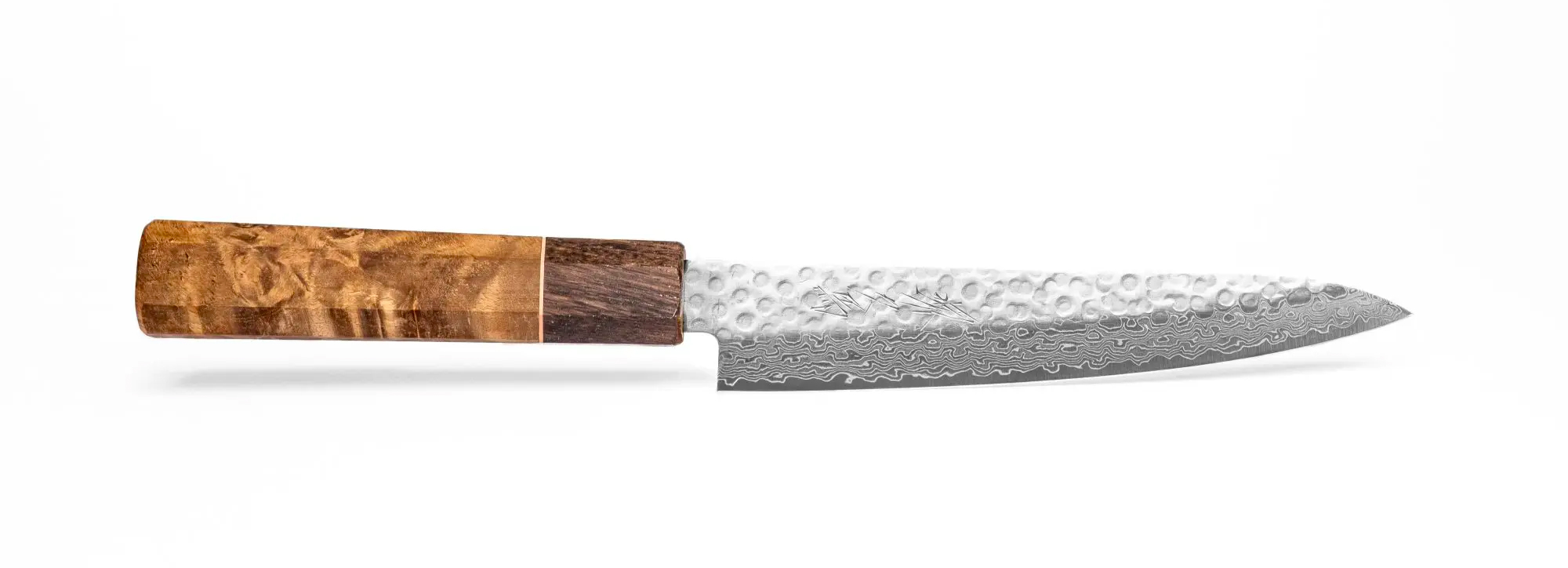
The Petty knife, sometimes referred to as a utility knife, is a small, versatile knife with a narrow blade and a pointed tip. It is ideal for intricate tasks that require precision and control, such as peeling, trimming, and intricate cutting work. The Petty knife is also well-suited for working with smaller ingredients and delicate herbs. Its compact size and maneuverability make it a go-to tool for intricate culinary work.
2.7 Sujihiki
The Sujihiki, also known as the slicer, is a long, narrow knife designed for slicing cooked meats, roasts, and other proteins. It features a thin, flexible blade that allows for smooth, precise slicing motions. The Sujihiki’s long blade ensures clean cuts without tearing or crushing the meat fibers, resulting in visually appealing slices. Whether you’re preparing a Sunday roast or slicing through tender cooked meats, the Sujihiki is the perfect tool for achieving uniform slices with ease.
2.8 Usuba
The Usuba, or the Japanese vegetable cleaver, is a traditional Japanese knife with a rectangular-shaped blade and a single bevel edge. It is specifically designed for precise vegetable cutting and preparation in Japanese cuisine. The Usuba’s thin, sharp blade allows for clean, delicate cuts on vegetables, while the flat surface of the blade makes it easy to scoop and transfer ingredients. If you’re passionate about Japanese cuisine and enjoy the art of vegetable carving and intricate cuts, the Usuba is a remarkable tool to have in your kitchen.
2.9 Honesuki
The Honesuki is a unique and specialized Japanese knife that deserves its own mention. This knife, also known as a boning knife, is specifically designed for the intricate task of deboning poultry. Its name translates to “bone slicer,” highlighting its purpose in the kitchen. The Honesuki features a sharp, narrow blade with a triangular shape and a pointed tip. This shape allows for precise maneuvering around bones and joints, ensuring minimal waste and maximum yield. With its exceptional precision and control, the Honesuki is an indispensable tool for home cooks who frequently work with poultry and seek to master the art of deboning with ease.
3. Specialized Japanese Knife Styles
3.1 Damascus Knives
Damascus knives are known for their stunning, distinctive patterns on the blade. These patterns are created through a process of layering and folding different types of steel together, resulting in a blade with exceptional strength, sharpness, and visual appeal. The intricate patterns are not only aesthetically pleasing but also indicate the skill and craftsmanship involved in their creation. Damascus knives are highly sought after by home cooks and collectors alike for their beauty and cutting performance.
3.2 Honyaki Knives
Honyaki knives are considered the pinnacle of Japanese knife craftsmanship. These knives are made from a single piece of high-carbon steel, with no layering or cladding. The forging process requires exceptional skill and precision, as any mistakes cannot be corrected or repaired. Honyaki knives are renowned for their extraordinary sharpness, edge retention, and ability to achieve an incredibly fine edge. Due to the complexity and meticulousness of their production, honyaki knives are rare and often come with a higher price tag.
3.3 Kasumi Knives
Kasumi knives are characterized by their beautiful, layered blade construction. They consist of a hard high-carbon steel core, known as hagane, surrounded by softer stainless steel, known as jigane. This layered construction combines the best of both worlds, providing the hardness and sharpness of the hagane for the cutting edge while offering the corrosion resistance and ease of maintenance of the stainless steel. Kasumi knives are a popular choice among home cooks who desire the performance of high-carbon steel but prefer the convenience of stainless steel.
3.4 Kurouchi Knives
Kurouchi knives showcase a rustic and unpolished appearance that adds to their unique charm. These knives are characterized by their black, rough-textured finish on the blade, resulting from the iron oxide layer left after the forging process. The kurouchi finish not only enhances the knife’s aesthetics but also provides additional protection against corrosion. Kurouchi knives are favored by those who appreciate the traditional, handcrafted look and desire a knife with a distinct character.
3.5 Suminagashi Knives
Suminagashi knives are known for their mesmerizing, marbled patterns on the blade. This pattern is achieved through a technique called suminagashi, where layers of different-colored steel are repeatedly folded and forged together. The resulting pattern resembles flowing water or rippling waves, creating a visually captivating effect. Suminagashi knives are not only visually stunning but also boast excellent cutting performance and durability.
3.6 Tamahagane Knives
Tamahagane knives are crafted using the ancient art of traditional Japanese sword-making. The term “tamahagane” refers to the specific type of steel used in these knives, which is derived from a combination of iron sand and charcoal. This process results in a high-quality steel with exceptional hardness, edge retention, and sharpness. Tamahagane knives are highly regarded for their craftsmanship, as they are often hand-forged by skilled artisans following time-honored techniques.
Each of these specialized Japanese knife styles offers unique characteristics, aesthetics, and cutting performance. Whether you’re drawn to the stunning patterns of Damascus knives, the exquisite craftsmanship of honyaki knives, or the rustic charm of kurouchi knives, there is a Japanese knife style that will suit your preferences and elevate your culinary experiences.
4. Choosing the Right Japanese Knife
3.1 Consider Your Cooking Style and Preferences
When selecting a Japanese knife, it’s essential to consider your cooking style and the tasks you frequently perform in the kitchen. Are you a fan of Japanese cuisine and enjoy preparing sushi and sashimi? Or do you prefer a versatile, all-purpose knife for a variety of tasks? Understanding your cooking style and preferences will help you narrow down your options and choose the knife that best suits your needs.
3.2 Blade Material and Construction
Japanese knives are available in different blade materials, each offering unique characteristics. High carbon steel blades are renowned for their exceptional sharpness and edge retention, but they require regular maintenance to prevent rust. Stainless steel blades, on the other hand, are easier to maintain and more resistant to corrosion. Consider your preferences and maintenance capabilities when selecting the blade material.
Additionally, pay attention to the blade construction, as it can impact the knife’s performance. Traditional hand-forged blades offer a level of craftsmanship and quality that is highly regarded. Machine-made blades, on the other hand, are more affordable and offer consistent quality. Consider your budget and desired level of craftsmanship when making a decision.
3.3 Handle Type and Comfort
The handle plays a significant role in the overall comfort and control of the knife. Traditional Japanese handles, known as “Wa-handle,” are often made of wood or horn, providing a natural and ergonomic grip. Western-style handles, known as “Yo-handle,” incorporate materials like plastic or synthetic materials, offering a different feel and grip. Consider your hand size, grip preferences, and comfort when choosing the handle type.
3.4 Budget
Japanese knives can range in price from affordable options to high-end, handcrafted masterpieces. Determine your budget and prioritize the features that are most important to you. While handcrafted knives can be a significant investment, they offer exceptional quality and craftsmanship. However, there are also excellent machine-made options available that provide excellent performance at a more affordable price point. Set a budget that aligns with your needs and explore the options within that range.
4. Using Japanese Knives: Techniques and Tips
4.1 Proper Storage
Proper storage is essential to protect the blade and ensure safety in your kitchen. Avoid storing Japanese knives loosely in drawers or containers where they can rub against other utensils or get damaged. Ideally, invest in a knife block, magnetic strip, or knife sheath to keep the blade protected and prevent accidental cuts. When storing multiple knives together, make sure to keep them separated to avoid potential blade damage. Additionally, store your knives in a dry environment to prevent moisture build-up, which can lead to rust formation.
4.2 Regular Cleaning
After each use, it is crucial to clean your Japanese knives thoroughly to remove any food residue or stains. Hand wash the knife with warm water and mild dish soap, using a soft sponge or cloth. Avoid using abrasive materials or harsh chemicals that can damage the blade or handle. Rinse the knife thoroughly and dry it immediately with a clean towel to prevent water spots or corrosion. Avoid soaking the knife in water for extended periods as this can lead to rusting or damage to the handle.
4.3 Honing and Sharpening
Maintaining a sharp edge is crucial for the optimal performance of your Japanese knives. Regular sharpening will ensure that your knives remain efficient and safe to use. There are various methods to sharpen Japanese knives, including whetstones, honing rods, and electric sharpeners. Whetstone sharpening is a popular choice as it allows for precise control and customization of the sharpening angle. It is recommended to follow the manufacturer’s instructions or seek guidance from a professional to ensure proper sharpening techniques and angles for your specific knife.
Honing is the process of realigning the blade’s edge between sharpenings. It helps to maintain the knife’s sharpness and prolong the time between sharpening sessions. Japanese knives with a higher hardness level may require less frequent honing compared to softer knives. To hone your knife, use a honing rod or a ceramic honing rod specifically designed for Japanese knives. Hold the knife at a 15-20 degree angle and gently swipe the blade along the honing rod, alternating sides. Remember not to apply excessive pressure during honing to avoid damaging the blade.
4.4 Knife Maintenance
Japanese knives are typically made of high-carbon steel, which is more prone to rust compared to stainless steel. To prevent rust formation, ensure that your knives are thoroughly dried after cleaning. If you notice any signs of rust, use a non-abrasive rust eraser or gently rub the affected area with a mixture of baking soda and water. Additionally, consider applying a thin layer of food-grade mineral oil on the blade to create a protective barrier against moisture and rust.
For complex maintenance tasks or major repairs, it is recommended to seek professional assistance. Professional knife sharpeners and repair services have the expertise and specialized equipment to handle intricate Japanese knives and restore them.
4.5 Proper handling and cutting techniques
Proper knife handling and cutting techniques can also contribute to the longevity of your Japanese knives. Avoid using the knife on hard surfaces such as glass or granite, as this can cause the blade to chip or dull prematurely. Use a cutting board made of wood, bamboo, or plastic, which will be gentler on the knife’s edge. When cutting, use a controlled and fluid motion, avoiding excessive force or twisting of the blade. Avoid using Japanese knives for tasks that they are not designed for, such as opening cans or cutting through bones, as this can damage the blade and compromise its performance.
5. Frequently Asked Questions
5.1 Are Japanese Knives Suitable for Home Cooks?

As a passionate home cook who values the joy and fulfillment that comes from creating delicious meals, you may be wondering if Japanese knives are suitable for your culinary adventures. At Oishya, we believe that Japanese knives, particularly our bestselling Sakai Kyuba Damascus high-carbon stainless steel knives, are the perfect companion for home cooks who seek to elevate their cooking experience and unleash their culinary creativity.
Japanese knives have long been revered for their exceptional craftsmanship, precision, and cutting performance. With their rich heritage rooted in centuries-old traditions of Japanese sword-making, these knives embody the essence of artistry, tradition, and functionality. But let’s dive deeper into why Japanese knives are an excellent choice for home cooks who are passionate about their craft.
- Unmatched Sharpness
One of the defining features of Japanese knives is their unparalleled sharpness. Crafted with meticulous attention to detail, each blade is honed to a razor-sharp edge that effortlessly glides through ingredients. The ultra-sharp edge ensures precise and clean cuts, allowing you to maintain the integrity and presentation of your culinary creations. Whether you’re slicing delicate sashimi, finely dicing vegetables, or carving a succulent roast, the exceptional sharpness of Japanese knives will enhance your cutting experience and elevate the quality of your dishes.
- Precision and Control
Japanese knives are renowned for their balance and ergonomic design, providing exceptional control and maneuverability. The careful shaping of the blade and handle allows for a comfortable grip, reducing fatigue during extended periods of chopping, slicing, and mincing. With precise control over the knife, you can execute intricate techniques with ease, resulting in uniform slices and precise cuts. Whether you’re a seasoned home cook or a culinary enthusiast just beginning your journey, the precision and control offered by Japanese knives will enhance your skills and elevate your culinary prowess.
- Versatility
While Japanese cuisine has its own unique requirements, Japanese knives are versatile tools that excel in various culinary tasks. From delicate filleting and slicing of fish to precise vegetable preparation, these knives adapt to a wide range of ingredients and cooking techniques. The Sakai Kyuba Damascus knives, in particular, are crafted to offer a balance between strength, flexibility, and precision, making them suitable for a multitude of kitchen tasks. Whether you’re exploring traditional Japanese recipes or experimenting with international flavors, Japanese knives will prove to be reliable and versatile companions in your culinary journey.
- Durability and Longevity
Japanese knives, when properly maintained, are built to last a lifetime. The combination of high-carbon stainless steel in our Sakai Kyuba Damascus knives ensures excellent durability, resistance to staining, and minimal maintenance requirements. With the right care and attention, these knives will retain their sharpness and performance for years to come, allowing you to enjoy their exceptional quality and craftsmanship in your kitchen.
- Aesthetics and Craftsmanship
Japanese knives are not just tools; they are works of art that reflect the rich cultural heritage and craftsmanship of Japan. The intricate designs, patterns, and finishes found in Japanese knives, such as the Damascus pattern in our Sakai Kyuba knives, add a touch of elegance and beauty to your kitchen. Displaying these knives in your kitchen is not only a testament to your love for culinary excellence but also a celebration of the artistry and traditions that go into their creation.
5.2 How Do Japanese Knives Differ from Western Knives?
Japanese knives and Western knives are distinct in their design, construction, and purpose. Understanding the differences between these two styles of knives can help you make an informed decision when selecting the perfect knife for your culinary needs. Let’s explore the key characteristics that set Japanese knives apart from their Western counterparts.
- Blade Construction
One of the most noticeable differences between Japanese and Western knives lies in their blade construction. Japanese knives typically feature a thinner and lighter blade compared to the thicker and heavier blades of Western knives. This distinction is a result of different cutting techniques and culinary traditions.
Japanese knives are crafted using a combination of high-carbon steel, which allows for exceptional sharpness and edge retention. The blades are often ground to a finer edge, resulting in superior cutting performance for precise and delicate tasks. In contrast, Western knives typically utilize softer stainless steel or high-carbon stainless steel alloys, which offer durability and resistance to staining and corrosion.
- Blade Profile and Edge
The blade profile of Japanese knives tends to be flatter and straighter, with a more acute cutting angle. This design allows for precise and clean cuts, making Japanese knives ideal for intricate tasks such as vegetable and fish preparation. The flatter profile also facilitates the traditional chopping and push-cutting techniques commonly used in Japanese cuisine.
In contrast, Western knives often feature a more curved blade profile, allowing for a rocking motion during cutting. This curved profile is well-suited for tasks that require a back-and-forth rocking motion, such as mincing herbs or cutting through thicker and tougher ingredients.
The edge geometry also differs between Japanese and Western knives. Japanese knives typically have a single bevel edge, known as “honyaki,” which is sharpened on one side only. This asymmetrical edge allows for incredibly precise cuts but requires a specific technique for sharpening and maintenance.
Western knives, on the other hand, commonly feature a double bevel edge, known as a “V” edge, which is sharpened on both sides. This symmetrical edge provides a more robust cutting edge that is easier to maintain and sharpen for most home cooks.
- Knife Balance and Handling
Japanese knives are renowned for their exceptional balance and ergonomic designs. The weight distribution of Japanese knives tends to be more centered towards the blade, providing optimal control and maneuverability. This balance allows for precise and controlled cuts with minimal effort, reducing fatigue during extended periods of use.
Western knives, on the other hand, often have a more handle-heavy balance, which can provide a different feel and handling experience. This balance is designed to accommodate the rocking motion commonly used in Western cooking techniques.
- Cutting Techniques and Culinary Traditions
Japanese and Western cuisines have distinct cutting techniques and culinary traditions, which have influenced the design and functionality of their respective knives.
Japanese knives excel in precision tasks such as slicing sashimi, filleting fish, or creating intricate vegetable cuts. The razor-sharp edges and fine blade profiles of Japanese knives allow for the utmost precision and control, enabling the creation of beautifully presented dishes. These knives are designed to enhance the delicate flavors and textures of Japanese cuisine.
Western knives, on the other hand, are versatile tools suited for a wide range of culinary tasks. Their sturdy construction and curved blade profiles make them ideal for tasks such as chopping, mincing, and rock chopping. Western knives are well-suited for preparing hearty meals that require cutting through tougher ingredients and handling larger cuts of meat.
- Aesthetics and Cultural Significance
Japanese knives are not just culinary tools; they are an embodiment of Japanese craftsmanship, tradition, and cultural significance. The artistry and attention to detail in the forging and finishing processes result in visually stunning knives. From the exquisite Damascus patterns to the intricately designed handles, Japanese knives often showcase the beauty and heritage of Japanese culture. Owning a Japanese knife is a testament to your appreciation for culinary excellence and the art of Japanese craftsmanship.
In contrast, Western knives prioritize functionality and practicality over intricate aesthetics. While Western knives may not feature elaborate designs, they are known for their robust construction and durability, making them reliable workhorses in the kitchen.
Ultimately, the choice between Japanese and Western knives depends on your personal preferences, culinary style, and the tasks you commonly perform in the kitchen. Whether you lean towards the precision and artistry of Japanese knives or the versatility and durability of Western knives, selecting the right knife will enhance your cooking experience and help you unleash your culinary creativity.
5.3 Can I Use Japanese Knives for Different Types of Cuisine?
Japanese knives are renowned for their exceptional craftsmanship, razor-sharp edges, and precise cutting abilities. While they are often associated with Japanese cuisine, it is important to note that Japanese knives can be used effectively in various types of cuisine beyond just Japanese dishes. Let’s explore how Japanese knives can elevate your culinary experience across different cuisines.
- Asian Cuisine
Japanese kitchen knives naturally excel in Asian cuisine due to their design and characteristics that align with the techniques and ingredients commonly used in this culinary tradition. Whether you’re preparing Chinese stir-fries, Thai curries, or Vietnamese spring rolls, Japanese kitchen knives offer the precision and control needed for delicate vegetable cuts, precise slicing of proteins, and intricate knife work.
For example, when making stir-fries that require quick and precise vegetable cuts, a Japanese nakiri knife or a santoku knife can be your go-to tools. The thin, sharp blade of a nakiri knife allows for effortless slicing and dicing of vegetables, while the versatility of a santoku knife enables you to handle various tasks from slicing meat to mincing herbs. The precision and sharpness of Japanese kitchen knives ensure that your Asian-inspired dishes are visually appealing and evenly cooked.
- European Cuisine
While Japanese knives may not be the traditional choice for European cuisine, they can still be effectively utilized to enhance your cooking experience. The precision and sharpness of Japanese knives are valuable assets when preparing European dishes that require intricate knife work and precise cuts.
When working with delicate ingredients such as fish or herbs, a Japanese yanagiba or deba knife can be incredibly useful. The long, thin blade of a yanagiba knife allows for clean, precise slicing of fish for dishes like Carpaccio or Sashimi. Similarly, the thicker, robust blade of a deba knife is well-suited for tasks like filleting fish or breaking down poultry.
Even in tasks like chopping vegetables or slicing meat, a Japanese gyuto or chef’s knife can offer excellent performance. The sharpness and balance of these knives allow for effortless and controlled cutting, enabling you to achieve uniform slices and precise julienne cuts.
- Fusion and Modern Cuisine
In today’s culinary landscape, where fusion and modern cuisines thrive, the versatility and precision of Japanese knives make them invaluable tools for chefs and home cooks alike. Whether you’re experimenting with new flavor combinations or creating visually stunning dishes, Japanese knives can help you bring your culinary visions to life.
For innovative plating techniques or artistic vegetable cuts, a Japanese usuba or kiritsuke knife can be your trusted companion. The usuba knife’s flat blade and straight edge excel in creating intricate vegetable designs, while the kiritsuke knife combines the functionality of a chef’s knife and a yanagiba knife, allowing for versatility in various cutting techniques.
Additionally, the exceptional sharpness and edge retention of Japanese knives ensure that even the most delicate ingredients maintain their integrity and flavors. Whether you’re working with tender cuts of meat, delicate seafood, or precision-cutting fruits and vegetables for innovative presentations, Japanese knives deliver the precision and control necessary for successful fusion and modern cuisine.
While Japanese knives have a strong association with Japanese cuisine, their exceptional craftsmanship and cutting performance make them versatile tools that can be used across a wide range of cuisines. From Asian to European, fusion to modern, Japanese kitchen knives provide the precision, control, and sharpness needed to elevate your culinary creations. By incorporating Japanese knives into your kitchen arsenal, you can unleash your creativity, achieve precise cuts, and enhance your overall cooking experience, regardless of the type of cuisine you’re exploring.
Once you own a Japanese knife, you’ll want more of them
We hope you’ve learned a lot from our guide to Japanese kitchen knives. Delving into the world of Japanese kitchen knives opens up a realm of culinary possibilities. The rich cultural heritage, meticulous craftsmanship, and unparalleled cutting performance make Japanese kitchen knives a valuable addition to any home cook’s arsenal. By understanding the different types and styles of Japanese knives, you can choose the perfect tool that aligns with your cooking style, preferences, and budget. Whether you’re slicing delicate sashimi, dicing vegetables with precision, or perfecting your knife skills, Japanese knives empower you to elevate your culinary creations. Embrace the artistry and tradition of Japanese knife-making and embark on a remarkable culinary journey with these exceptional tools. Happy cooking!










